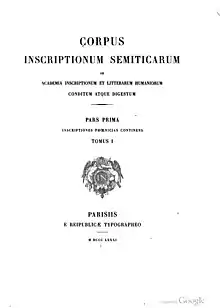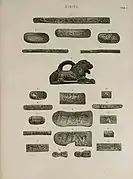Corpus Inscriptionum Semiticarum
The Corpus Inscriptionum Semiticarum (abbreviated CIS) is a collection of ancient inscriptions in Semitic languages produced since the end of 2nd millennium BC until the rise of Islam. It was published in Latin. In a note recovered after his death, Ernest Renan stated that: "Of all I have done, it is the Corpus I like the most."[1]

The first part was published in 1881, fourteen years after the beginning of the project. Renan justified the fourteen year delay in the preface to the volume, pointing to the calamity of the Franco-Prussian war and the difficulties that arose in the printing the Phoenician characters, whose first engraving was proven incorrect in light of the inscriptions discovered subsequently.[2] A smaller collection – Répertoire d'Épigraphie Sémitique (abbreviated RES) – was subsequently created to present the Semitic inscriptions without delay and in a deliberately concise way as they became known, and was published in French rather than Latin. The Répertoire was for the Corpus Inscriptionum Semiticarum what the Ephemeris epigraphica latina was for the Corpus Inscriptionum Latinarum.
The publication of the series continued until 1962.
History
The project began on April 17, 1867 when the French Académie des Inscriptions et Belles-Lettres accepted the proposal of a commission led by Ernest Renan to begin an initiative similar to German corpora of ancient Latin and Greek Corpus Inscriptionum Graecarum (CIG), and Corpus Inscriptionum Latinarum (CIL). It was decided that the collection should contain all the ancient inscriptions written in "Semitic characters", excluding the Semitic cuneiform inscriptions.
The original plan of the work to produce ten books:
- I. Phoenician, punic and neopunic;
- II. Hebrew language and Samaritan language, facsimiles of ancient Hebrew and Samaritan manuscripts;
- III Aramaic language;
- IV. Palmyrene; See inscriptions Nabatean;
- V. Syriac language;
- VII. in Mandaic language;
- VIII. early Arabic;
- IX. Himyaritic;
- X. Amharic language
The program was then divided into five parts:
- Part I. Phoenician, Punic and neo-Punic inscriptions;
- Part II. Aramaic, Palmyra, Nabatean inscriptions;
- Part III. Hebrew inscriptions;
- Part IV. Himyaritic, Sabaean;
- Part V. Saracen, Lihyan, Safaitic and Thamudic.
The Répertoire d'Épigraphie Sémitique (abbreviated RES) published inscriptions during intermediate periods.
Volumes
Corpus Inscriptionum ab Academia Inscriptionum et Litterarum Humaniorum conditum atque Digestum. Parisiis: E Reipublicae Typographeo, 1881-1962
Part I. Phoenician, Punic and neo-Punic inscriptions. This series brought together the Phoenician inscriptions found in Phoenicia itself, in Cyprus, in Egypt, in Greece, in Malta, in Sicily, in Sardinia, in Italy, in Gaul, in Spain, and in particular the vast number of North African Punic inscriptions, particularly from Carthage. Renan continued to edit this series until his death in 1892.[3]
- Pars 1, Tomus 1: Corpus Inscriptionum Semiticarum : Fasc. 1 (1881) and Corpus Inscriptionum Semiticarum : Tabulæ (images);
- Pars 1, Tomus 1: Fasc. 2 (1883);
- Pars 1, Tomus 1: Fasc. 3 (1885);
- Pars 1, Tomus 1: Fasc. 4 (1887);
- Pars 1, Tomus 2: Corpus Inscriptionum Semiticarum Fasc. 1 (1890);
- Pars 1, Tomus 2: Corpus Inscriptionum Semiticarum Fasc. 2 (1899); and Corpus Inscriptionum Semiticarum Tabulæ (images);
- Pars 1, Tomus 2: Corpus Inscriptionum Semiticarum Fasc. 3 (1908); and Corpus Inscriptionum Semiticarum Tabulæ (images);
- Pars 1, Tomus 2: Corpus Inscriptionum Semiticarum Fasc. 4 (1911); and Corpus Inscriptionum Semiticarum Tabulæ (images);
- Pars 1, Tomus 3: Fasc. 1; Tabulae (images): Corpus Inscriptionum Semiticarum (1926)
Part II. Aramaic, Palmyra, Nabatean inscriptions. Edited by Eugène-Melchior de Vogüé, this series began publication in 1889, covering the territory of the ancient Syrian kingdoms, as well as all the countries where Aramaic penetrated under the Persian empire, from Anatolia to the India, from the Caspian to Upper Egypt.[3]
- Pars 2, Tomus 1: Corpus Inscriptionum Semiticarum (1889) and Corpus Inscriptionum Semiticarum Tabulæ (images);
- Pars 2, Tomus 2, Fasc 1: Corpus Inscriptionum Semiticarum (1907) and Corpus Inscriptionum Semiticarum Tabulæ
- Pars 2, Tomus 3: Fasc. 1 (1951) Corpus Inscriptionum Semiticarum at the Internet Archive Tabulæ (images);
Part III. Hebrew inscriptions; this series was not published. However, a number of Hebrew inscriptions were systematically published in the Répertoire d'Épigraphie Sémitique.
Part IV. Himyaritic, Sabaean. This volume, first published in 1889, was edited by Joseph Derenbourg. It covers the Arabian Peninsula, particularly the Himyarite and Sabean inscriptions.[3]
- Pars 4, Tomus 1: Corpus Inscriptionum Semiticarum Fasc. 4 (1889); and Corpus Inscriptionum Semiticarum Tabulae (images)
- Pars 4, Tomus 2, Fasc 1: Corpus Inscriptionum Semiticarum Tabulae (images)
- Pars 4, Tomus 2, Fasc 2: Corpus Inscriptionum Semiticarum Tabulae (images)
- Pars 4, Tomus 2, Fasc 3+4: (1920) Corpus Inscriptionum Semiticarum Tabulae (images)
- Pars 4, Tomus 3, Fasc 2, Tabulae (images): Corpus Inscriptionum Semiticarum
Part V. Saracen, Lihyan, Safaitic and Thamudic; this series was not published until 1950, by Gonzague Ryckmans[4]
- Pars 5, Tomus 1, Fasc 1: (1950)
Répertoire d'Épigraphie Sémitique.
- Volume 1: Corpus Inscriptionum Semiticarum (1900-05) under the direction of Charles Simon Clermont-Ganneau, as assistant to Jean-Baptiste Chabot
- Volume 2: Corpus Inscriptionum Semiticarum (1907-14) edited by Jean-Baptiste Chabot
- Volumes 3-8 were edited by Jean-Baptiste Chabot until his death in 1948, then Jacques Ryckmans until the last volume in 1968.
Leadership
List of Presidents of the "Commission du Corpus Inscriptionum Semiticarum":[5]
- Ernest Renan (d.1892)
- Hartwig Derenbourg (d.1908)
- René Dussaud (d.1958)
- Jean-Baptiste Chabot (d.1948)
- André Dupont-Sommer (d.1983)
- André Caquot (d.2004)
Gallery
 CIS I 1: Yehawmilk Stele
CIS I 1: Yehawmilk Stele CIS II 1: Assyrian lion weights
CIS II 1: Assyrian lion weights.jpg.webp) CIS I 3-4 and 6-9
CIS I 3-4 and 6-9 CIS I 5: Baal Lebanon inscription
CIS I 5: Baal Lebanon inscription
References
- 1867 Initiation: Renan Ernest. Rapport fait à l'Académie des Inscriptions et Belles-Lettres par la commission spéciale chargée de l'examen du projet d'un Corpus inscriptionum semiticarum. In: Comptes rendus des séances de l'Académie des Inscriptions et Belles-Lettres, 11ᵉ année, 1867. pp. 77–85:
- Académie des Inscriptions et Belles-Lettres, CORPUS INSCRIPTIONUM SEMITICARUM CABINET
- René DUSSAUD, La nouvelle Académie des Inscriptions et Belles-Lettres (1795-1914), 2 volumes I et II, Paris, P. Geuthner, 1946–1947, p. 289, 425, 745, 748 entre autres.
- André DUPONT-SOMMER, « Renan et le Corpus des Inscriptions sémitiques », Comptes rendus des séances de l’Académie, 1968/4, Paris, Académie des Inscriptions et Belles-Lettres, p. 3-14.
- André CAQUOT, « L’épigraphie sémitique. Discours de clôture de l’Année épigraphique », Comptes rendus des séances de l’Académie, 1988/3, Paris, Académie des Inscriptions et Belles-Lettres, p 10–15.
- Jean LECLANT, « Une tradition : l’épigraphie à l’Académie des Inscriptions et Belles-Lettres », Comptes rendus des séances de l’Académie, 1988/4, Paris, Académie des Inscriptions et Belles-Lettres, p. 3-21.
- Françoise Briquel Chatonnet, Catherine Fauveaud-Brassaud. Ad majorem scientiae fructum. Le Corpus inscriptionum semiticarum dans les correspondances conservées à l’Institut de France. C. Bonnet et V. Krings. S’écrire et écrire sur l’Antiquité. L’apport des correspondances à l’histoire des travaux scientifiques, Jérôme Millon, pp. 215–228, 2008. hal-00334567
Notes
- Willemetz Geneviève, [https://www.persee.fr/doc/renan_0046-2659_1991_num_84_1_1417 Sciences et techniques autour d'Ernest Renan. In: Études Renaniennes, N°84, 2e trimestre 1991. pp. 3-5: "De tout ce que j’ai fait, c’est le Corpus que j’aime le mieux"
- Pars 1, Tomus 1, p.XI-XII: "Neque hos viros culpandos facilius credas quod inde ab anno 1867, inter opus decretum et inceptum, anni quatuordecim, grande mortalis ævi spatium, intercesserunt. Hoc enim temporis intervallo, quæ patriæ clades, qui civiles tumultus, quæ rerum novarum cæca exspectatio! Porro ea fuit operis hujus conditio, ut cultius auctiusque prodire magis oporteret quant festinantius in publicum emitti. Neque vero nos culpæ, si qua est, pœnitet, quandoquidem operi instituto mora plus boni quant detrimenti altulit..."
- Dupont-Sommer, 1968, p.543
- Irvine, A. (1970). Obituary: Gonzague Ryckmans. Bulletin of the School of Oriental and African Studies, University of London, 33(2), 374-377. Retrieved July 31, 2020, from www.jstor.org/stable/613015
- Académie des Inscriptions et Belles-Lettres, CORPUS INSCRIPTIONUM SEMITICARUM CABINET